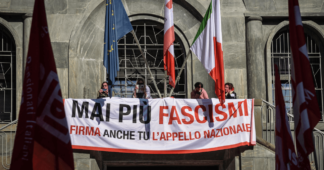When a few weeks ago in Italy the right-wing alliance won the parliamentary and senatorial elections, the president of the partisan ANPI spoke of the “sarcasm of history”. Indeed, one is reminded of Karl Marx’s saying, great things repeat themselves, one time as tragedy, the other time as farce.
One hundred years ago, at the end of October 1922, when Benito Mussolini came to power, a tragedy began for Italian society. Already the advance of the fascist movement in the “Biennio Nero” of 1921/1922 was associated with increasing fascist violence. Mussolini had asserted himself as “Duce” in the leadership circle of the fascist movement at the end of 1921 and had formed the local Squadren and Fasci di Combattimento into a party.
One function of the violent formation of the “Blackshirts” was to massively fight, in the interests of the entrepreneurs and landowners, the revolutionary and social movement that was fighting for a socialist transformation of the country through factory and land occupations. It was not the Italian state but the fascist forces that ensured capitalist property and power relations. Soon the fascists raised the question of political power and demanded new parliamentary elections. If their demand was not met, they intended to enforce it with a “March on Rome.”
On October 1-2, 1922, the fascists demonstrated against the German ethnic group with a “March on Bolzano”, as they envisioned the advance. They experienced that the security forces of the Italian state did not stop this activity, the state apparatus seemed to be on their side. At the end of October 1922, Mussolini then announced a “march on Rome” to take over the Italian government by force if necessary. Sporadically, local administrations (prefectures and police stations), transportation hubs, and barracks were occupied. Several tens of thousands of Mussolini’s supporters gathered at the gates of Rome. Fascist propaganda spoke of 70,000; it was probably between 40,000 and 50,000 men.
Significant was the reaction of the Italian elite. Prime Minister Luigi Facta hesitated for a long time to declare a state of emergency that could have used the army against the fascists. Finally, King Vittorio Emanuele III refused to give his consent, because representatives of the military, as well as right-wing liberals and nationalists in the Italian Parliament, had sided with Mussolini. Luigi Facta resigned. Former Prime Minister Salandra persuaded the king to appoint Mussolini as the new prime minister. On October 30, 1922, the king appointed him head of government. Only now did the fascist formations march to Rome, where a parade was held on October 31, 1922. Afterwards, as in the days before, there were raids on socialist and communist press offices and acts of violence against their supporters.
The fascists’ way to power in Italy in the fall of 1922 was thus anything but a “revolutionary” action, as it is still propagated today with the glorification as the “March on Rome” in fascist self-promotion. The example of Italy clearly shows the function of fascism in securing political power.
At the same time, the advance of the fascist Black Shirts was also the beginning of a non-party anti-fascist movement, the “Arditi del Populi,” which organized itself as mass self-protection across ideological boundaries.
If the repetition of history with the government of the fascist right in Italy with the cabinet of Giorgia Meloni can achieve anything, then the intensified uniting of all anti-fascist forces in Italy in a “new anti-fascism”. This is oriented against neo-fascism and the ideas of exclusion, racism and nationalism and for a political, cultural and legal struggle that goes in a “social direction”, as ANPI underlined. In this struggle, FIR and its member federations will support the Italian anti-fascists and the civil society forces.
October 27, 2022, at 5 pm, ANPI organize an historic-political online event “March – never again!”. One can follow this event on ANPI Facebook-side.
We remind our readers that publication of articles on our site does not mean that we agree with what is written. Our policy is to publish anything which we consider of interest, so as to assist our readers in forming their opinions. Sometimes we even publish articles with which we totally disagree, since we believe it is important for our readers to be informed on as wide a spectrum of views as possible.












